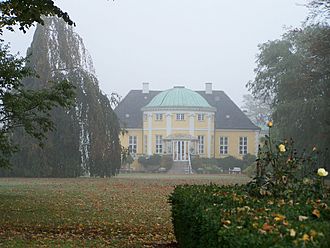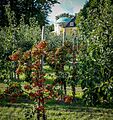Frydenlund facts for kids
Quick facts for kids Fredenslund |
|
|---|---|

Frydenlund
|
|
| General information | |
| Architectural style | Neoclassical |
| Location | Rudersdal, Denmark |
| Country | Denmark |
| Coordinates | 55°50′27.34″N 12°33′29.11″E / 55.8409278°N 12.5580861°E |
| Construction started | 1726 |
| Completed | 1729 |
| Design and construction | |
| Architect | Jørgen Henrich Rawert |
Frydenlund is a historic house located near Vedbæk, a town north of Copenhagen, Denmark. This grand building has a long and interesting past, once serving as a royal hunting lodge and later becoming a private home. Today, it is known for its beautiful architecture and the famous people who have lived there.
Contents
A Look Back: Frydenlund's Royal Past
The First Royal Hunting Lodge
The story of Frydenlund began with a hunting lodge. This first building was constructed around 1670, just north of the royal deer park called Jægersborg Dyrehave. It was a place for royalty and nobles to stay when they went hunting.
In the 1680s, a man named Conrad von Reventlow bought the property. He was from Holstein and named the pavilion "Freudenlund."
Queen Anne Sophie's Home
After Conrad von Reventlow passed away, his daughter, Anne Sophie Reventlow, inherited the property. She later married King Frederick IV of Denmark. From 1722 to 1726, a royal architect named Johan Cornelius Krieger made the house much bigger.
In the 1740s, the house was used by General Charles Christian Erdmann, Duke of Württemberg-Oels.
A Gift for Queen Caroline Matilda
King Frederick V of Denmark later updated the house. In 1760, he gave it to his son, Crown Prince Christian VII of Denmark. When Christian married Caroline Matilda of Great Britain in 1764, Frydenlund became her special gift.
Queen Caroline Matilda enjoyed spending time at Frydenlund. In 1770, a new wooden mansion was built nearby in Lille Dyrehave. This new building was designed by Caspar Frederik Harsdorff.
Changes Over Time: Frydenlund's Transformations
The Fire and Rebuilding
Sadly, the mansion designed by Harsdorff was destroyed by a fire in 1793. After the fire, the Danish Crown (the royal family) sold the estate. It was bought by Karl Adolf Boheman, a Swedish merchant.
Boheman worked with architect Jørgen Henrich Rawert to fix up and expand the older house that Krieger had built. This helped Frydenlund get a new start after the fire.
Modern History and New Uses
Many years later, in 1957, the famous American-Danish entertainer Victor Borge bought Frydenlund. He was known for his comedy and piano playing.
In 1960, Victor Borge sold the property to Haldor Topsøe. This company turned the buildings into a research center.
Frydenlund's Design: Architecture Details
The Frydenlund house you see today is a Neoclassical building. This style is known for its simple, elegant look, often inspired by ancient Greek and Roman buildings. The house has three main parts, or wings.
The original house from the 1720s, built by Krieger, was a tall, eight-sided building made with timber. You can still see this part today as a rounded section on the main wing of the house.
Frydenlund was officially protected as a historic building in 1918. In 2010, an architectural company was hired to create a plan for restoring and developing the buildings.
Owners of Frydenlund
- (-1669) H. Ehm (copper mill owner)
- (1670-1683) M. Friis
- (17xx-17xx) Conrad Reventlow
- (17xx-17xx) Anna Sophie Reventlow
- (17xx-1793) The Crown (Danish Royal Family)
- (1793-1803) Carl Adolf Boheman
- (1803-1813) W.B. Linstow
- (1813-1840) Cecilie M. E. Schouw
- (1840-1843) H. Outzen Bjørn
- (1843-1846) J.L. Gottlieb
- (1846-1875) Gertrudine Rieffestahl
- (1875-1907) L. Castenschiold
- (1907-1929) C.B. Thøgersen
- (1929-1957) G.K. Schiørring
- (1957-1960) Victor Borge
- (1960-) Haldor Topsøe
Images for kids





